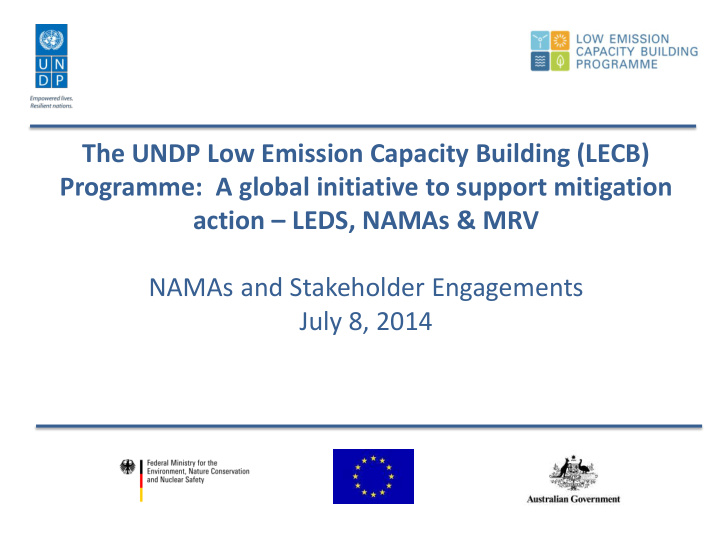



The UNDP Low Emission Capacity Building (LECB) Programme: A global initiative to support mitigation action – LEDS, NAMAs & MRV NAMAs and Stakeholder Engagements July 8, 2014
Introduction • Overview of the LECB Programme • LECB stakeholder engagement strategy o Engagement objectives and outputs o NAMA-specific engagement considerations • Case Study examples
LECB Programme – Overview (1) Objective: Build capacities to design and implement Low Carbon Development through national mitigation actions in the public and/or private sectors Five main work areas:3 GHG inventory management systems Nationally Appropriate Mitigation Actions (NAMAs) Low-Emission Development Strategies (LEDS) Measurement, Reporting and Verification (MRV) Participation of selected industries in mitigation actions Donors: • European Commission, German and Australian Governments
LECB Programme - Overview (2) Start date: January 2011 End date: December 2016 Funding: $40 million Scale: 25 countries Sectors: Energy, transport, industrial processes, waste, agriculture, and LULUCF Industries: Cement, iron and steel, fertilizers, mining, construction, chemicals Deliverables: - 60 NAMAs with MRV systems - 13 LEDS - 17 national GHG inventory systems to support NAMAs and LEDS
LECB partner countries Phase Africa Asia LAC Arab States Europe/CIS Phase 1 DRC Philippines Argentina Egypt (2011) Kenya China Chile Morocco Uganda Colombia Zambia Ecuador Mexico Peru Phase 2 Ghana Bhutan Costa Rica Lebanon Moldova (2012) Tanzania Indonesia Trinidad & Tobago Malaysia Thailand Vietnam Total # 6 7 8 3 1
LECB model for low carbon development 1. Put in place a multi-stakeholder framework (for project development, national steering committee, working groups) 2. Maximise use of national experts (with tailored technical assistance provided, based upon country needs) 3. Focus on institutional capacity building needs to support a country- driven process 4. Learn from diverse capacities and experiences, ranging from LDCs to medium-income countries and large emerging economies
LECB model for low carbon dev’t (2) 5. Encourage consideration of gender issues to provide opportunities that support gender agendas in participating countries, as appropriate 6. Build on existing experience within UNDP Green, low-emission, climate-resilient development strategies: extensive resource base developed Lessons from UNDP- GEF’s climate change mitigation portfolio (barrier removal, MRV systems, nascent work on NAMAs, etc) Capacity Development Group’s approaches to strengthening and measuring institutional capacities National Communications Support Programme & other enabling activities under GEF
LECB value-added for addressing capacity development barriers Creates a culture of global exchange and peer-to-peer learning Seeks insights from participating countries on their approaches & experiences to emerging issues Peer-to-peer learning via webinars, e-discussions, thematic working groups, annual global meetings & bilateral technical assistance Coordinated, targeted technical assistance Technical assistance through technical briefs, targeted backstopping (in-country and on-line), and thematic trainings Drives results-based knowledge sharing Sharing of best practices/lessons learned Information sharing via www.lowemissiondevelopment.org and monthly email “round - ups” of events
LECB Stakeholder Engagement Strategy 1. Structured dialogues, multi-stakeholder consultations, workshops, outreach events 2. Country-driven approach • Best judge of whom to invite, most appropriate stakeholders, important cultural aspects, and to maximize local expertise. • LECB local project Coordinators, local government focal point (MoF, MoE), UNDP Country Office • UNDP NY office provides global view, technical backstopping 3. Align NAMAs and LEDS to national development plans 4. Climate change risks and impacts are cross-sectoral so it’s critical to take an inclusive approach for multiple levels of society
Stakeholder Engagement Objectives (1) 1. Increase practical likelihood proposed actions and plans will be accepted, implemented, and effective / sustainable 2. Create ownership, capacity, and consensus about the strategy 3. Bring together sectoral interests 4. Gather information and data 5. Address opportunities and potential inconsistencies Government: coordination across ministries, long-term strategic vision Communities: prominent role in decision-making, on-the-ground expertise
Stakeholder Engagement Objectives (2) Civil Society: NGOs and NGO networks, raise awareness about climate change, focus on the most vulnerable, improve local livelihoods, conduct research, disseminate information, build capacity, advocacy to influence governments Private sector: create a favorable investment climate, attract private investment International community: coordinate donor support, identify gaps and priorities in international financing
How this looks in practice 1. Each of 25 country LECB project budgets have clearly denoted budget lines for stakeholder engagements 2. Existing and new networks and collaboration (e.g., cross- ministerial working groups, steering committees, project board) 3. Regional and national Private Sector Workshops to raise interest in business opportunities in climate change mitigation activities 4. Support NAMA prioritization Climate finance readiness (NAMA Facility 3 rd Call, GCF Proposal) 5. • Please identify the relevant actors for achieving the intended impacts within the sector and how they interact. • How will the project ensure an adequate involvement of relevant stakeholders? • Please specify the multi-stakeholder engagement plan and the consultations that were conducted when this proposal was developed
NAMA-Specific SE Considerations 1. Less confidence since no track record of success 2. Emphasis on the financial bottom line - how much will cost, who will bear these costs, how to access climate finance 3. Use case studies and practical examples in-country or region. 4. Levels of expertise can vary widely (disseminate training materials and conduct pre-training sessions prior to workshops) 5. Focus on buy-in and ownership to drive the process (esp. government) 6. Continually improve, e.g., post-engagement participant surveys
LECB NAMA Examples 1. Kenya pilot NAMA project on ICS and SHS: local community NGO reach out to local communities – raise awareness, collaboration with schools, training of project administrators and technicians 2. Indonesia Jakarta Bus Rapid Transit (BRT) NAMA: consultations created mutual understanding through frequent meetings and communication - critical for data collection from multiple ministries, private bus companies, and academia 3. Costa Rica NAMA pilot project to reach out to livestock farmers to use innovative sustainable livestock management techniques 4. Ecuador cook-stove upgrade NAMA from LPG to high-efficiency electric induction: institutions collaborate to establish work groups, introduce the new technology, develop a communication strategy, train manufacturers, and design MRV with those implementing on the ground
Thank You! James Vener, PE James.vener@undp.org www.lowemissiondevelopment.org 2012 Multi-Stakeholder Decision-Making (UNDP) (www.undp.org/content/dam/undp/library/Environment%20and%20Energy/Clima te%20Strategies/Multi-stakeholder%20Decision-Making_Sept%202012.pdf) 2013 Guidance for NAMA Design (UNFCCC, UNDP, DTU) (www.lowemissiondevelopment.org/docs/resources/Guidance_for_NAMA_Design_20 13_.pdf)
Recommend
More recommend